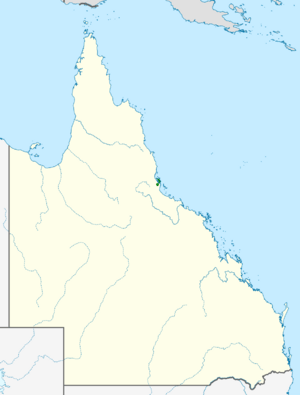Dallachy's blue banksia facts for kids
Quick facts for kids Dallachy's Banksia |
|
|---|---|
 |
|
| Conservation status | |
|
Rare (NCA)
|
|
| Scientific classification | |
| Kingdom: | |
| (unranked): | |
| (unranked): | |
| Order: | |
| Family: | |
| Genus: | |
| Species: |
B. plagiocarpa
|
| Binomial name | |
| Banksia plagiocarpa A.S.George
|
|
Banksia plagiocarpa, also known as the Dallachy's banksia or blue banksia, is a type of shrub or small tree. It belongs to the plant genus called Banksia.
This special plant only grows in a specific area. You can find it on Hinchinbrook Island in Queensland, Australia, and on the mainland right next to the island. It was first collected in 1867. However, it wasn't officially named until 1981 by a botanist named Alex George. Scientists have studied its genes and found that it is related to other banksia species like Banksia aquilonia and Banksia robur.
What Does It Look Like?
The Dallachy's banksia usually grows as a shrub, reaching up to 5 meters (about 16 feet) tall. It has bark that is grey and looks a bit broken.
When new parts of the plant grow, they are covered in soft, red, velvety fur. This fur usually falls off after two or three years.
The leaves are long and narrow, shaped like a spear or a wider oval. They grow one after another along the stems. Each leaf is about 8 to 20 cm (3 to 8 inches) long and 0.6 to 1.7 cm (0.2 to 0.7 inches) wide. Their edges curve slightly backward and have blunt, saw-like teeth.
The flowers appear in spikes, which are also called inflorescences. These flower spikes show up from February to July. They are about 7 to 14 cm (3 to 5.5 inches) tall and 5 to 6 cm (2 to 2.4 inches) wide when they are fully open. The spikes grow at the end of branches or on branches that are one to two years old. Sometimes, small twigs grow in a circle around the base of the flower spike.
How It Got Its Name
The Dallachy's banksia was first collected by John Dallachy in December 1867 and February 1868. He was collecting plants for a government botanist. He found the plant on Bishops Peak in the Cardwell Ranges.
Dallachy described the flowers as "pale blue," which was unusual. Later, in 1979, Fred Hockings collected it again from Hinchinbrook Island. He described the flowers as "greenish-purple."
Finally, in 1981, Alex George officially described and named the species. The scientific name, plagiocarpa, comes from ancient Greek words. Plagios means "sloping" or "oblique," and carpos means "fruit." This refers to how the seed pods, called follicles, are shaped like an upturned wedge.
Besides its scientific name, it's commonly known as Dallachy's banksia or blue banksia.
Scientists like Alex George have organized all the different types of banksias. Banksia plagiocarpa is placed within the main Banksia group because its flowers grow in the typical banksia spike shape.
Since 1998, scientists have been using DNA information to understand how different banksia species are related. These studies show that Banksia plagiocarpa is closely related to Banksia aquilonia, Banksia oblongifolia, and Banksia robur.
Where It Grows

Banksia plagiocarpa only grows in a small area. You can find it on Hinchinbrook Island, where it grows on the top and sides of Mount Bowen and Nina Peak. It also grows on the nearby mainland of Queensland's north coast, specifically on the top and sides of Bishops Peak.
This area gets a lot of rain, about 2400 mm (94 inches) each year. The plant lives in open woodlands or grasslands. Sometimes, it's the most common shrub in these areas.
On Hinchinbrook Island, it grows at heights between 200 and 720 meters (about 650 to 2360 feet) above sea level. It prefers gravelly, rocky, or clay soils. You might find it growing with other plants like tantoon (Leptospermum polygalifolium) and she-oaks (Casuarina). It also grows near Banksia aquilonia at lower heights, below 400 meters (about 1300 feet). On the mainland, it grows in sandier soil, often close to water.
Growing Your Own Banksia
The Dallachy's banksia is quite easy to grow in gardens. It does well if the soil drains water easily and if it gets plenty of sunshine.
It has been successfully grown in cooler places, like the Australian National Botanic Gardens in Canberra. It takes about four to five years for the plant to flower when grown from a seed.
People like to grow it for its unique look. Its flower buds are a cool gunmetal grey-blue color, and its new growth is a bright red. It's also grown to be used as cut flowers.

